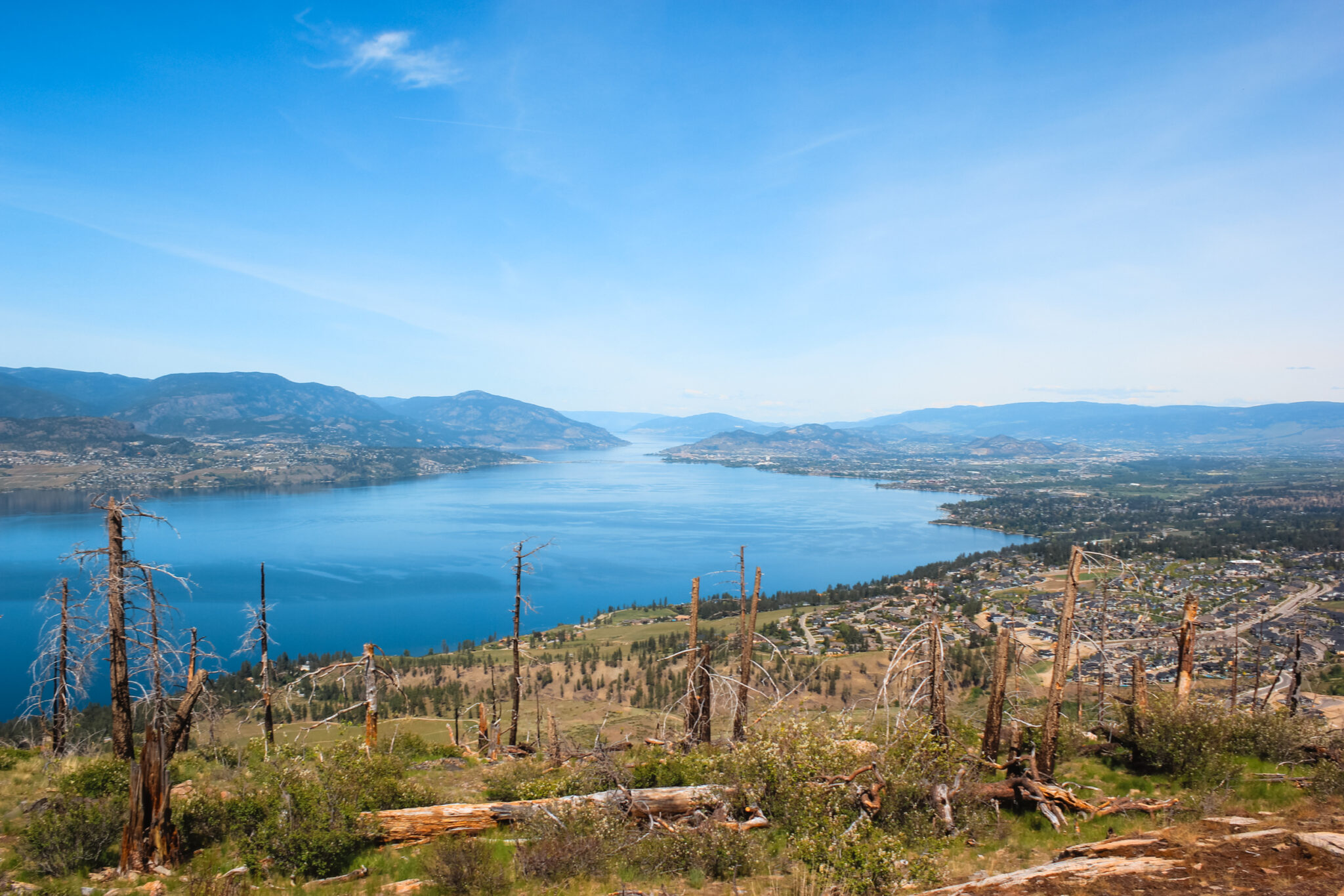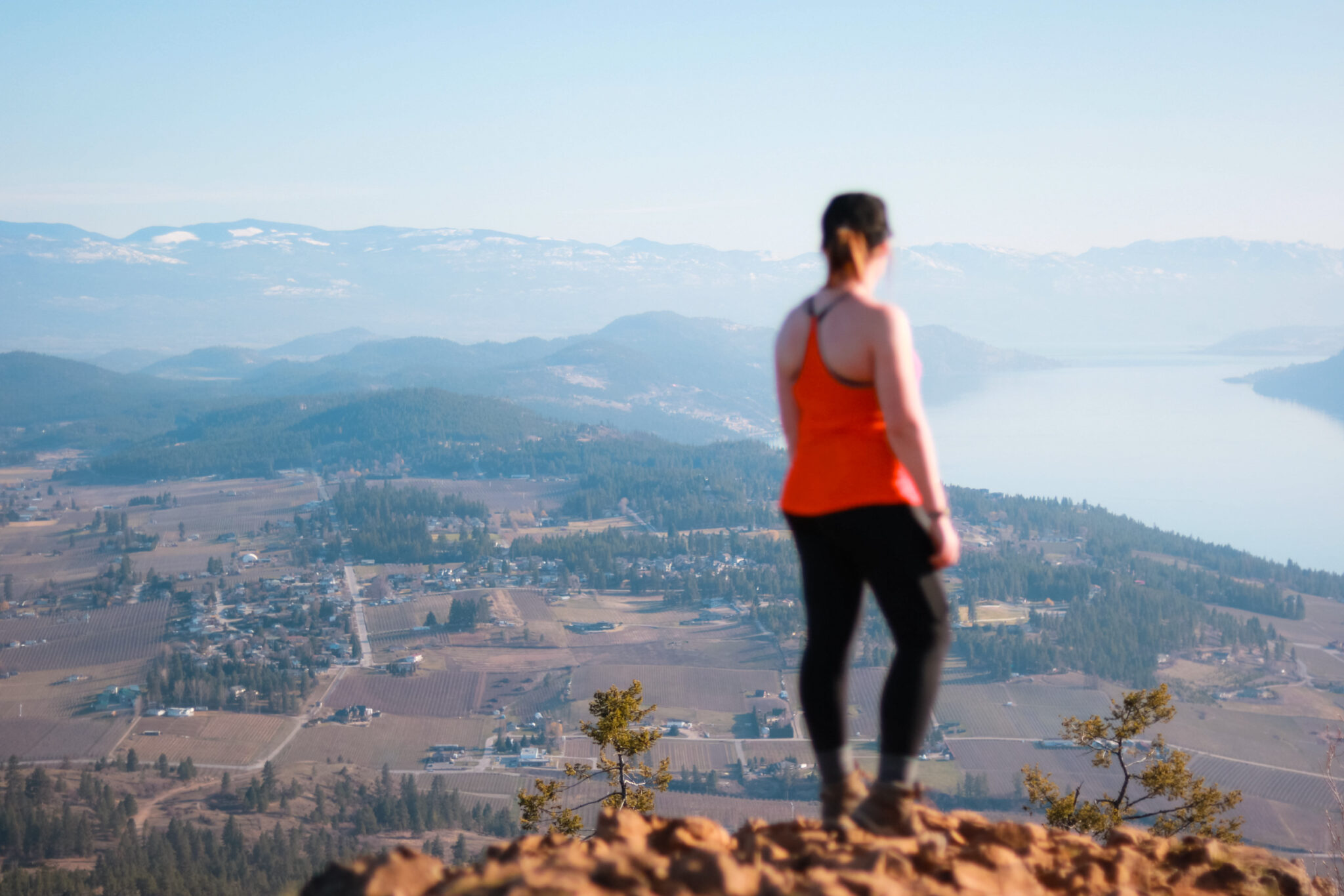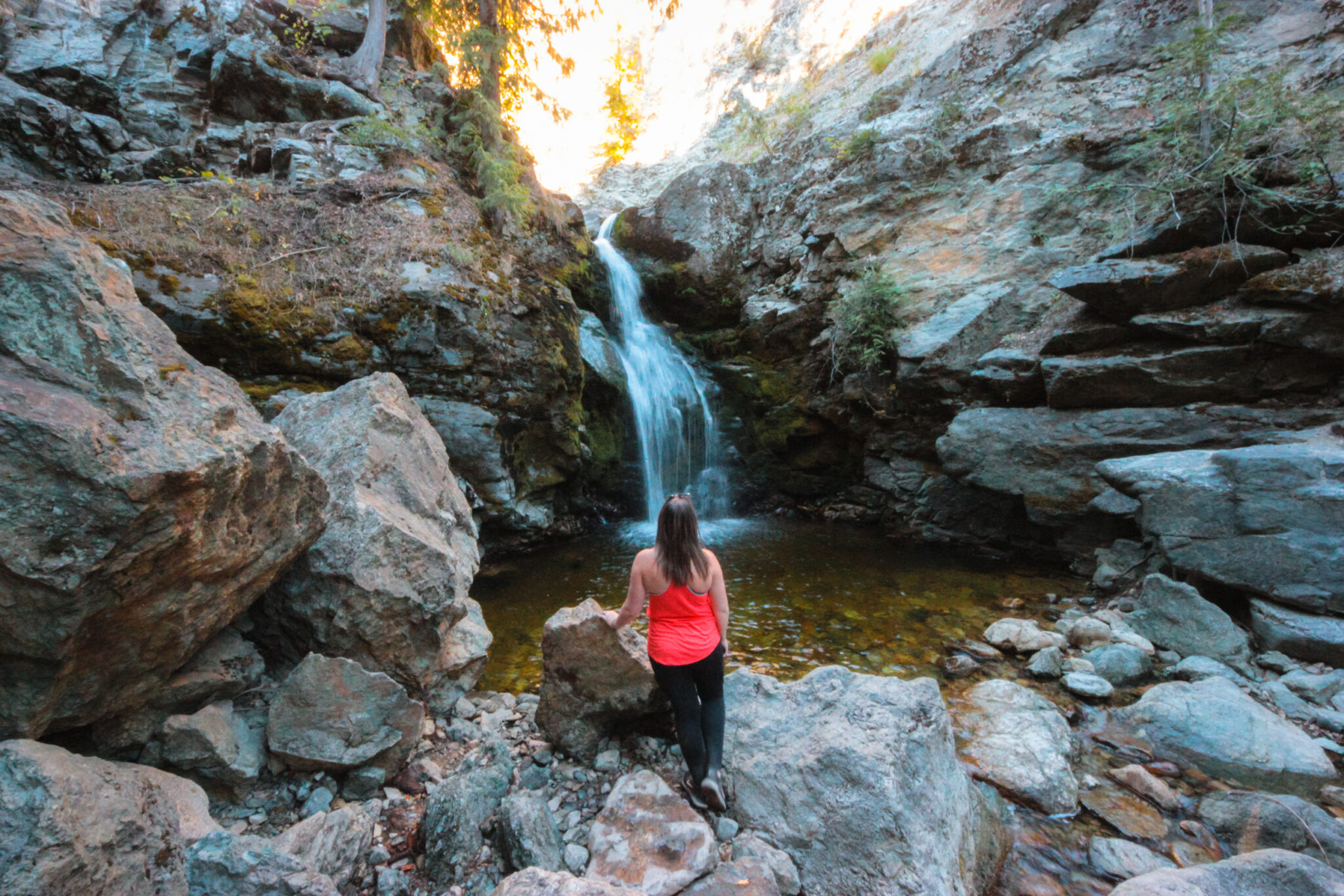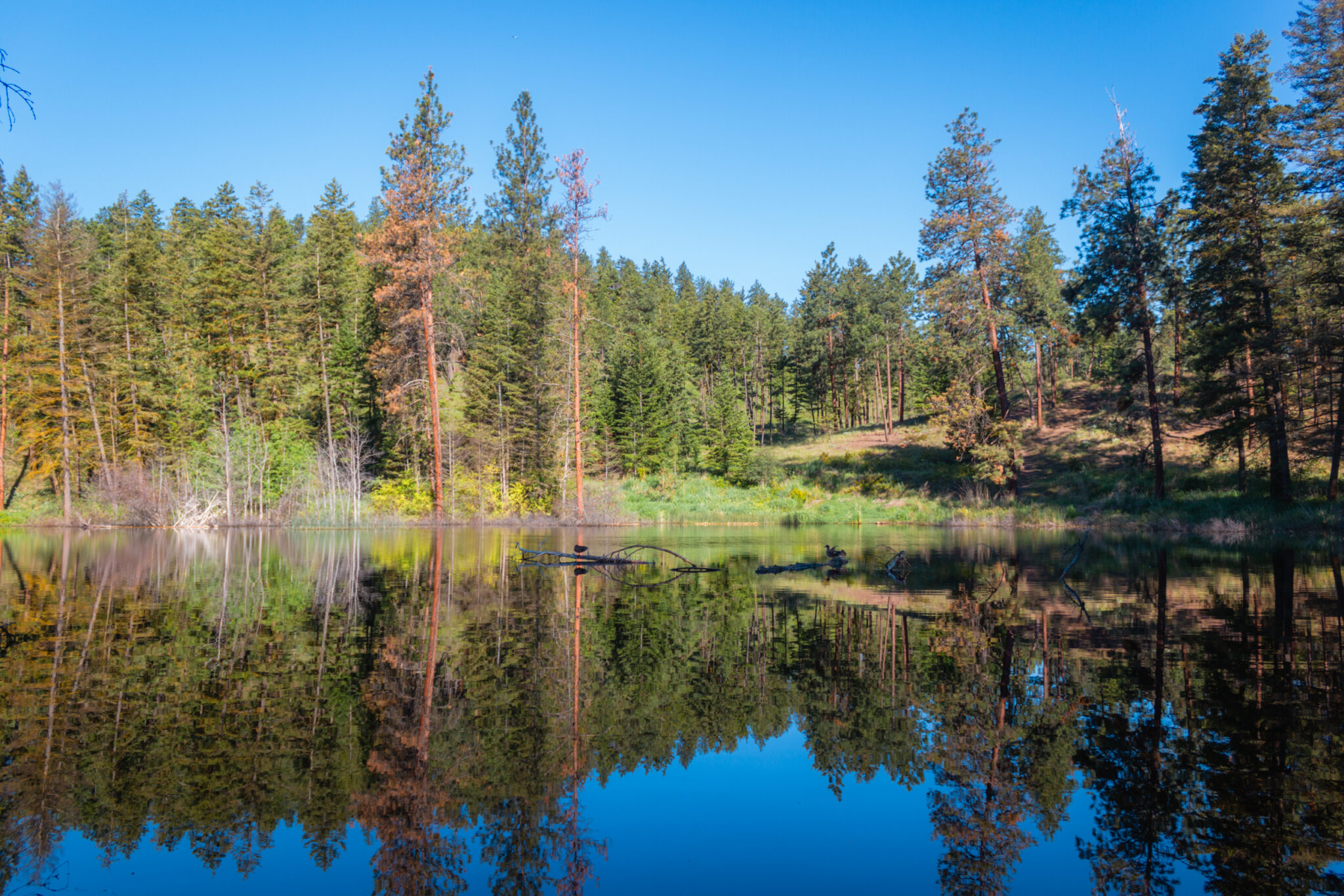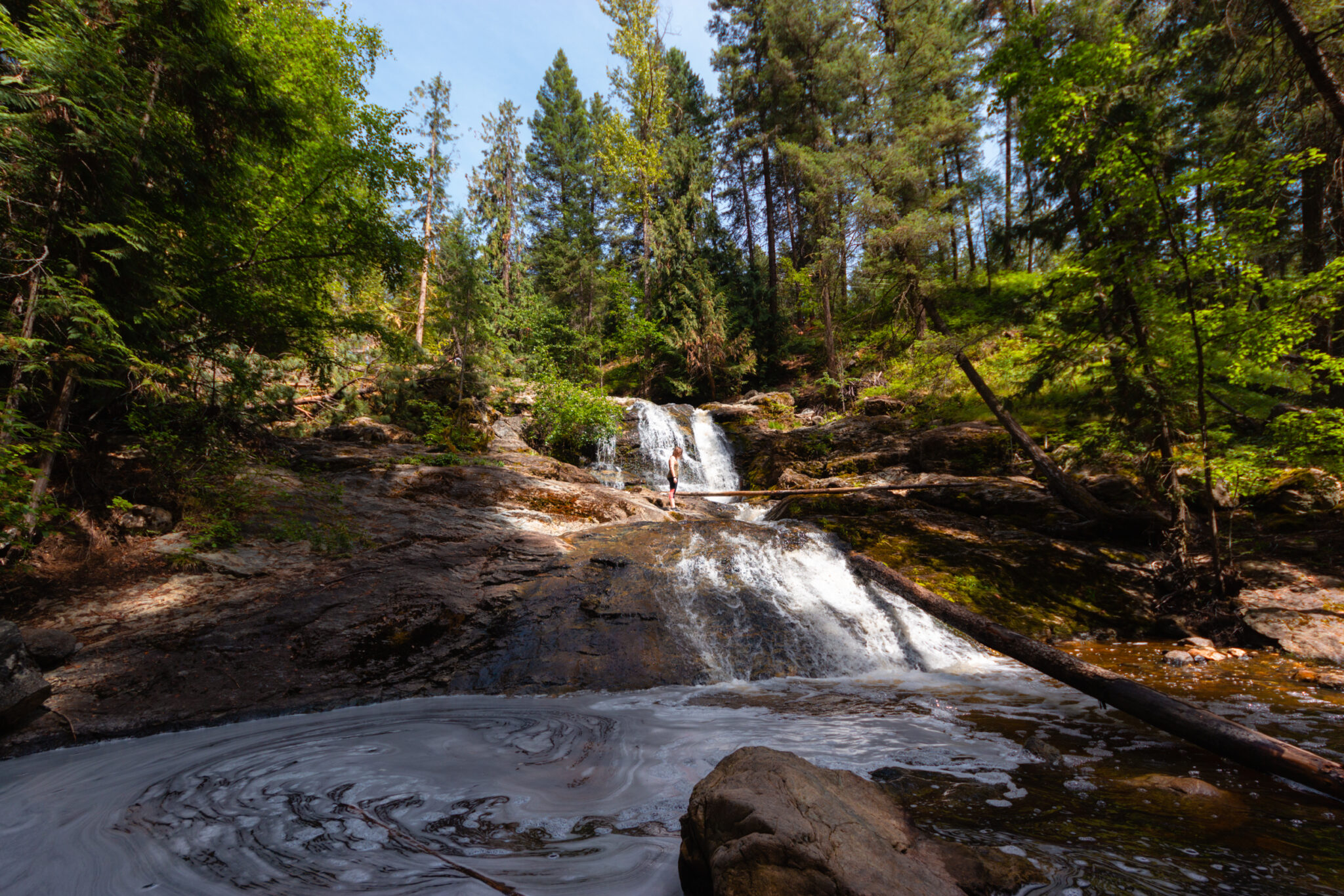20+ Overnight Backpacking Trails in the Okanagan

An overnight backpacking trip in the Okanagan is one of the best ways to experience the natural beauty the valley has to offer. With its beautiful landscapes, sky-blue lakes, and impressive mountains, the Okanagan is full of backpacking trips.
You’ll find 20+ backpacking trails in this guide ranging from complete beginner to advanced. From Kelowna to Osoyoos to Revelstoke, backpacking in the Okanagan is always a great experience that’ll leave you with lifelong memories.
The great thing about backpacking in the Okanagan is that there are trails for all experience levels. Totally new to backpacking? Try Spectrum Lake or Buchan Bay. Into harder trips? Try the High Rim Trail, Big Peters Lake, or Mark Berger Traverse.
This isn’t a comprehensive list of backpacking trails in the Okanagan, but it does cover the most popular (and a few not so popular) trails.
Some of the trails are a little past the technical Okanagan boundary, but they’re worth checking out. You can also backcountry camp on most Crown Land, which gives you lots of places to explore.
What to Bring on an Overnight Backpacking Trip in the Okanagan
The funny thing about backpacking is that the gear for a short trip is almost the same as a long trip. I won’t go into specific details here, but here’s the basic gear you should bring on an overnight backpacking trip in the Okanagan.
Hiking Essentials
The ten hiking essentials are an absolute for a backpacking trip. I wrote an entire article about these which I highly recommend you check out. To do a quick recap, the essentials are:
- Navigation (trail map, compass, and GPS)
- Sun protection (sunglasses, sunscreen, and appropriate clothing)
- Insulation (dress in layers)
- Illumination (headlamp)
- First aid supplies (premade or create your own)
- Fire (ferro rod, waterproof matches, electric lighter)
- Repair kit and tools (knife, repair kit)
- Nutrition
- Hydration (water filter, aqua tablets)
- Emergency shelter (emergency blanket)
Packing List
Most gear you bring for backpacking in the Okanagan will fall under the ten essentials. Here are a few of the other items in my backpack — bonus items only come if I’m okay with extra weight:
- Lightweight tent
- MSR water filter
- Rumpl blanket (bonus item)
- Helinox chair (bonus item)
- Sleeping bag
- Hiking poles
- Merino wool socks x2
- Hiking boots
- Garmin inReach GPS & SOS
- Camp stove
- Down jacket
- Top and bottom base layer
Okanagan Mountain Park
Kelowna | Multiple routes
Okanagan Mountain Park in Kelowna is a popular area for overnight backpacking and has multiple trails. There are six backpacking campsites, plus four boat-in only sites. You can access the park from Lakeshore Road in Kelowna or Chute Lake Road in Naramata.
The mountain was ravaged by a wildfire in 2003, but today it’s once again a great place for hiking! Because of the fire, there are very few trees and views of Okanagan Lake are absolutely spectacular.
The trails get very hot and there are very few water sources on the mountain itself; be prepared with lots of water and sun protection.
Read more about staying hydrated in the heat »
Below you’ll find the wilderness campsites and recommended routes, but you can easily create your own backpacking route. Due to the hazards left over from the wildfire, it’s highly recommended you stay on-trail and camp at the designated campsites.
There are no fees or permits required for the hike-only sites on Okanagan Mountain; marine campsites are $13/night. All campsites are first-come, first served. Luckily, this isn’t a super popular area and there’s usually plenty of space.
Buchan Bay Marine Campsite
Okanagan Mountain Park (Boat- or Hike-In)
The Buchan Bay wilderness campsite is located on the southern part of Okanagan Mountain Park. It’s a beautiful backpacking campsite that sits right on Okanagan Lake.
There’s a designated gravel tent area or you can pitch a tent on the beach. There’s an outhouse, picnic table, and campfire ring, plus bedrock along the lakeshore. I love it here!
The Wildhorse Canyon to Buchan Bay route is a good beginner’s overnight backpacking trail because it’s mostly flat (except for the beginning and end). However, based on my experience, it’s a few kilometers longer than AllTrails says.
Commando Bay Marine Campsite
Okanagan Mountain Park (Boat- or Hike-In)
The Commando Bay wilderness campsite is located on Okanagan Lake and is a little further south than Buchan Bay. It’s also a great beginner’s overnight backpacking campsite!
There’s a protected area above the beach for camping, plus an outhouse, picnic table, and campfire ring.
Commando Bay is accessible via Wildhorse Canyon (the same trail as Buchan Bay) and you could easily make a multi-day backpacking trip by visiting the three campsites along the southern part of Okanagan Mountain Park. The longest part is getting to the campsites; once there, it’s only a short distance between each.
Good’s Creek Marine Campsite
Okanagan Mountain Park (Boat- or Hike-In)
The Good’s Creek wilderness campsite is the last of three lakeside backpacking sites on Okanagan Mountain. You can access it via the Wildhorse Canyon trail from Kelowna or Chute Lake Road in Naramata.
The Good’s Creek campsite is located on Okanagan Lake and is further south than Buchan Bay and Commando Bay. It’s a great place for an overnight backpacking trip!
Divide Lake Wilderness Campsite
Okanagan Mountain Park (Hike-In)
Divide Lake is one of two hike-in only wilderness campsites on Okanagan Mountain. It sits high in the mountain and is a grind. The trail follows a service road and the spectacular view is behind you the entire hike up — make sure to turn around to enjoy it!
It’s a very hot hike with few water sources until you reach the lake.
Once you reach Divide Lake, there’s a campsite with picnic tables, tent areas, and campfire rings plus an old, user-maintained cabin. The lake is nice, but fairly small. It’s a great place to fill up your water reserves and cool off. There’s also a bear hang.
Baker Lake Wilderness Campsite
Okanagan Mountain Park (Hike-In)
Baker Lake on Okanagan Mountain is the second of two hike-in only campsites in the park. Thanks to its high elevation in the mountains, you’ll have incredible views of Okanagan Lake as you hike up the grueling trail.
Coming from Kelowna, Baker Lake is just past Divide Lake and has a lot of elevation gain. You can also access it from Narmata.
It’s a very hot hike with few water sources until you reach the lake. There are tenting areas, campfire rings, and a pit toilet at Baker Lake. If it’s a hot day, enjoy a dip in the lake!
High Rim Trail
Kelowna to Vernon | 54 km
The High Rim Trail is a 54 km multi-day backpacking trip from Kelowna to Vernon. It begins at Highway 33 and ends in Kalamalka Lake Provincial Park; there are also many places along the way where you can get on or off the trail if you don’t want to hike the entire trail in one go.
The High Rim Trail isn’t for the faint of heart. It’s a challenging hike through the Okanagan mountains that features rugged and steep terrain, rocky areas, and not-well-marked trails. To make up for the difficulties, you’ll be rewarded with plenty of panoramic viewpoints, beautiful lakes and forests, and serene wilderness on your backpacking trip.
There are two designated campsites on the High Rim Trail: the Grand View (km 14.5) and Damer Lake (off-trail at km 45). You’ll find tent pads and outhouses at these campsites. Otherwise, you’ll have to set up your own campsite — be sure to practice Leave No Trace when doing this so others can enjoy the area, too.
There are no fees or permits required for the High Rim Trail.
Fur Brigade & Mt Eneas
Peachland to Summerland | 15 km
For an overnight backpacking trip in the heart of the Okanagan, try the Fur Brigade and Mt Eneas trail which brings you from Peachland to Summerland. This isn’t an official backpacking trail, but you can certainly make it into one.
The trail is beautiful, but not well-marked. A GPS is very important so you don’t lose your way due to the many forks and overgrown trails.
Kettle Valley Railway
Midway to Hope | 600 km
The Kettle Valley Railway is an extensive trail that spans from Midway to Hope and winds through many communities in BC.
As an abandoned railway route, the KVR has many places to hop on or off and is popular for hiking, biking, and ATVs. You can also easily create a multi-day backpacking trip along the route. Thanks to the low grade, the distance you hike will have more to do with your wants than physical limitations.
Check out these popular Okanagan routes to create your backpacking trip:
Spion Kop Network
Lake Country | Multiple trails
Spion Kop in Lake Country is known for its day-use hiking trails, but because it’s on Crown Land you can also turn it into an overnight backpacking trip.
There are no designated campsites and the trails are multi-use (motorized vehicles use them), so it’s very important to set up camp away from the trails. There are no water sources, so you’ll need to pack in all of your water.
Spion Kop is a good option for people who are new to overnight backpacking, but it can be a little disconcerting since it’s very much wilderness camping. There will likely be no one else camping overnight. Always practice Leave No Trace.
Monashee Provincial Park
Cherryville | Multiple trails
Monashee Provincial Park has numerous beautiful overnight backpacking trails! The routes range from beginner to experienced and offer something for everyone. There are four backcountry campsites (wilderness camping is also permitted).
The backpacking campsites in the Monashees are very much backcountry trails. There’s limited cell service (often none) so it’s important to bring a satellite GPS and the ten essentials for safety.
There’s a $5/person/night fee for backcountry campsite use; however, this does not reserve you a site. You can also camp outside of the designated campsites for free and you must practice Leave No Trace.
Technically, the Monashees are outside the Okanagan Valley, but since they’re so close I wanted to include them — you’ll find my geographic ranges for areas tends to be a little larger than they actually are. I cast a wide net if it makes sense.
Spectrum Lake Backcountry Site
Monashee Provincial Park
Spectrum Lake is a popular overnight backpacking trip for beginners, families, and shoulder-season; it’s also the first stop for deeper trips into the Monashee backcountry. There will likely be other people here.
Spectrum is the largest campground in the park and features wooden tent pads, covered shelters, pit toilets, campfire rings, and a dock. There’s also a large covered group site, bear cache, and bear hang. It’s a surprisingly amenity-rich campsite considering its remote location.
The area is incredibly lush. There’s plenty of water and the forest is comprised of moss and tall, thin trees.
Little Peters Lake Backcountry Site
Monashee Provincial Park
The Little Peters Lake campsite is 6.5km from Spectrum Lake and is a difficult hike with 762 m of elevation gain. Most people continue on to Big Peters Lake instead of camping here.
This is the most difficult trail section in the park so be prepared for a tough grind. The trail from Spectrum Lake is narrow and steep and passes through rocky terrain. You’ll be rewarded with stunning views if you can tough it out! Snow is often a concern and has been reported as late as July.
There are two wooden tent pads and a pit toilet at Little Peters Lake.
Big Peters Lake Backcountry Site
Monashee Provincial Park
The Big Peters Lake backcountry campsite is 4 km from Little Peters. Once you get through the difficult hike from Spectrum to Little Peters, the rest of the way to Big Peters is pretty flat.
There are 10 wooden tent pads scattered around the end of the lake. There’s also a bear cache, bear hang, and pit toilet.
People often use this as a base camp for day-hiking the surrounding area (such as Mt Fosthall, Fawn Lake, and Margie Lake), although you can continue deeper into the mountains to camp.
Margie Lake Backcountry Site
Monashee Provincial Park
Margie Lake is the final designated backcountry campsite in the Monashees and is 5 km from Big Peters Lake or 18 km from the trailhead. There are two wooden tent pads, a pit toilet, and bear hang.
This backcountry campsite is often used by people hiking Mt Fosthall from the Sol Mountain Lodge (a totally different route that doesn’t bypass Spectrum Lake).
Joss Mountain Fire Cabin
Monashee Mountains
The Joss Mountain Fire Cabin is located in the Monashee mountain range, not the provincial park. This is generally done as a day hike, but you can stay in the fire lookout at the top (no fees or permits required). The view is stunning!
There are two routes:
- The western approach is short but very steep and difficult — expect it to take longer than you think, especially with a heavy overnight backpack. Don’t listen to AllTrails, this is very much a difficult hike.
- The eastern approach is much longer but also a lot easier (see Shuswap Trail Alliance for details).
It’s highly recommended to use a GPS because the trail can become lost in a few areas. There’s no cell service.
Twin Lakes
Monashee Mountains | 8 km
Twin Lakes near Cherryville is a popular day hike and overnight backpacking trail in the Monashee mountains. And it’s no wonder! It’s a beautiful area with gorgeous views and turqouise lakes.
The hike in is fairly short, but there’s lots of elevation gain which make it more difficult. There are no designated campsites or amenities which make this a true wilderness camping experience.
Mark Berger Traverse
Monashee Mountains | 16.4 km
The Mark Berger Traverse is a very difficult, multi-day backpacking trip in the Monashees that’s only for experienced hikers. There’s no established trail and many sections are very technical. Do not attempt this trail unless you’re very experienced.
With all that in mind, this is a stunning hike and is the epitome of backcountry hiking!
Mara Mountain Fire Lookout
The Mara Mountain Fire Lookout is located on Morton Peak in the north Okanagan and the highest point in the Hunters Range area. This area is popular with snowmobilers in the winter and ATVs in the summer.
I haven’t been able to find definitive info about whether you can overnight camp here or not, but it’s similar to other fire lookouts in the area where you can stay.
There are two cabins you can enter along the way – the Owlhead Chalet and the fire lookout. While I believe you can stay overnight at either, I highly recommend doing your own research to confirm (if you find information, please let me know so I can update this article).
Cathedral Provincial Park
Keremoeos | Multiple trails
Cathedral Provincial Park is located near Penticton in the southern region of BC and is bordered by the USA. It’s much less well known than it’s nearby cousin, EC Manning Provincial Park, but deserves just as much praise. It’s a stunning backcountry area that requires very little effort to camp at!
There are two backcountry campsites within the park’s core (the third, Pyramid is closed), three wilderness camping sites outside the core, as well as numerous absolutely beautiful day-hikes. All campsites are first come first served.
To access the park, you either have to take a tiring full day’s hike or pay for a 1 hour 4×4 bus ride (pricey but often worth it). Private vehicles are not allowed in the park. Backcountry camping fees are $10/adult and $5/youth per night.
Quiniscoe Lake Backcountry Site
Cathedral Provincial Park
Quiniscoe Lake in Cathedral Provincial Park has 30 designated backcountry campsites which are spread out along the lake’s shoreline. It’s a five-minute walk from Cathedral Lakes Lodge which is where you’re dropped off by bus.
Each campsite has wooden tent pads and are arranged in groups of three to four to share the 12 picnic tables and 13 campfire rings. There are four pit toilets and a firewood corral at the nearby lodge.
The Quiniscoe Lake campground is an easy, low-stakes backcountry campsite that’s used as a base camp for stunning day-hikes in the park.
Lake of the Woods Backcountry Site
Cathedral Provincial Park
The Lake of the Woods backcountry campground has 28 rustic sites and is about 1 km away from the lodge. The campsites are more spread out and open than those at Quiniscoe.
Each campsite has a designated tent pad, but no tables or fire rings (campfires aren’t allowed at any time). There are two pit toilets.
From Lake of the Woods, you’ll enjoy absolutely beautiful views of the surrounding mountains!
Twin Buttes Backcountry Site
Cathedral Provincial Park
Twin Buttes is a wilderness campsite in the outer regions of Cathedral Provincial Park. It’s accessible via the Twin Buttes (Centennial) Trail and is about 8 km from the lodge.
There are no facilities here and you must practice Leave No Trace. Haystack Lakes and Lindsey Creek are two other wilderness campsites in Cathedral Lake, but I’m not 100% positive how to access them — if you have details, please feel free to reach out so I can update this section.
Mt Revelstoke National Park
Revelstoke | Eva and Jade Lakes
Mt Revelstoke National Park is a gorgeous park with two designated backcountry campgrounds, plus random wilderness camping.
Although it’s technically not in the Okanagan, I included Mt Revelstoke because it’s well within driving distance and is a great overnight backpacking trip.
The Eva and Jade Lakes campsites are reserveable from July 30 to September 30, otherwise they’re first come first served. You need a National Park Pass and backcountry camping permit to camp here.
Eva Lake Backcountry Site
Mt Revelstoke National Park
Eva Lake is located at the top of Mt Revelstoke. Luckily, you can drive most of the way up courtesy of the Meadows in the Sky Parkway. This is a great trail for beginner backpackers.
The campsite is ~7 km from the parking lot and many people do it as a day hike. Eva Lake is a small but absolutely beautiful alpine lake. There are four campsites available; two can be reserved, two are FCFS. There’s bear-proof storage, a pit toilet, and a picnic cabin. Campfires aren’t permitted.
Jade Lake Backcountry Site
Mt Revelstoke National Park
Jade Lake is the second designated backcountry site at Mt Revelstoke. It’s about ~12.5 km from the parking lot at the top of the Meadows in the Sky Parkway. The trail itself is easy to follow, but it has a lot of elevation gain.
The trail to Jade Lake is stunning and has beautiful, panoramic views of the surrounding mountains. It’s surpassingly quiet with very few people. There are four campsites; two can be reserved, two are FCFS. There’s bear-proof storage and a pit toilet. Campfires aren’t permitted.
